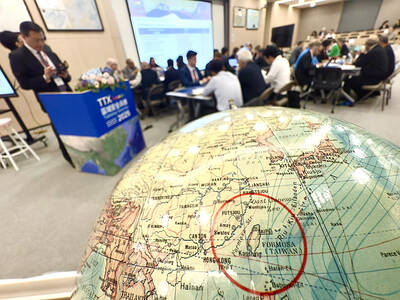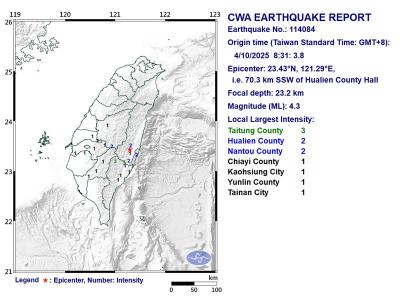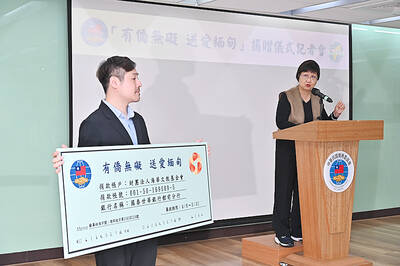President Ma Ying-jeou (馬英九) yesterday said he was confident Beijing had the same understanding of the “1992 consensus” as Taipei, adding that each side — both part of the same “Chinese nation” — had its own interpretation of “one China.”
Ma said he made clear in his inaugural address that his administration would maintain the “status quo” through the “three noes” under the framework of the Republic of China (ROC) Constitution and develop cross-strait relations on the basis of the “1992 consensus.”
The “three noes” refer to no discussion of unification with Beijing during Ma’s presidency, no pursuit of, or support for, de jure Taiwanese independence and no use of force to resolve cross-strait disputes.
Ma said the “1992 consensus” was an agreement reached by both sides in 1992 and Taiwan’s understanding was that each side had its own interpretation of what “one China” signifies.
“Recently, some representatives from the mainland Chinese authorities mentioned this consensus when they were here,” Ma said. “I believe their understanding is consistent with ours.”
However, on Feb. 21, 2006, then-Chinese Nationalist Party (KMT) legislator Su Chi (蘇起) admitted that he made up the term “1992 consensus” in 2000 when he was Mainland Affairs Council chairman. Su said he invented the term to break the cross-strait deadlock and alleviate tension before the KMT handed over power to the Democratic Progressive Party (DPP).
Ma said Taiwan and China had signed 14 agreements over the past two years “as a result of the consensus,” something he said had been a “rare occurrence” over the past 60 years.
“Both sides realize this is a historic juncture and should grasp the opportunity to improve bilateral ties as cross-strait detente is conducive to peace not only across the Taiwan Strait but also in East Asia and the whole world,” he said at the Presidential Office during a meeting with participants in an international forum on the People’s Liberation Army.
Some people recently proposed that Taipei and Beijing consider establishing a confidence-building mechanism (CBM), Ma said, but the Economic Cooperation Framework Agreement (ECFA) signed in June was a kind of CBM, because without mutual trust, both sides would not have signed such a complicated trade pact that requires both sides to commit to a long-term relationship.
Ma said his conciliatory approach was intended to ease cross-strait tensions so that Taiwan would have more time to respond to and become more capable of handling crises.
Taiwan must strengthen its defense capabilities, but it cannot afford to engage in an arms race with China, he said.
His administration would continue to purchase defensive weapons from the US that Taiwan cannot produce itself, but military hardware was not the only way to protect Taiwan, he said. This was why his administration has tried so hard to pursue economic and cultural exchanges with China, he said.
His cross-strait policy has -reduced tension across the Taiwan Strait and both sides have developed a certain degree of mutual trust, Ma said, adding that he hoped both sides would find the best solution to cross-strait disputes “under the guidance of Chinese culture” because both peoples are of one “Chinese nation” and all yan huang zisun (descendants of emperors Yan and Huang).
Ma sought to clarify his remarks about one “Chinese nation” later in the day, saying there were three common characteristics to the “Chinese nation”: They have the same ancestors and the same last names, come from the same towns and villages and go to the same schools.
ADDITIONAL REPORTING BY STAFF WRITER

DEFENSE: The National Security Bureau promised to expand communication and intelligence cooperation with global partners and enhance its strategic analytical skills China has not only increased military exercises and “gray zone” tactics against Taiwan this year, but also continues to recruit military personnel for espionage, the National Security Bureau (NSB) said yesterday in a report to the Legislative Yuan. The bureau submitted the report ahead of NSB Director-General Tsai Ming-yen’s (蔡明彥) appearance before the Foreign and National Defense Committee today. Last year, the Chinese People’s Liberation Army (PLA) conducted “Joint Sword-2024A and B” military exercises targeting Taiwan and carried out 40 combat readiness patrols, the bureau said. In addition, Chinese military aircraft entered Taiwan’s airspace 3,070 times last year, up about

A magnitude 4.3 earthquake struck eastern Taiwan's Hualien County at 8:31am today, according to the Central Weather Administration (CWA). The epicenter of the temblor was located in Hualien County, about 70.3 kilometers south southwest of Hualien County Hall, at a depth of 23.2km, according to the administration. There were no immediate reports of damage resulting from the quake. The earthquake's intensity, which gauges the actual effect of a temblor, was highest in Taitung County, where it measured 3 on Taiwan's 7-tier intensity scale. The quake also measured an intensity of 2 in Hualien and Nantou counties, the CWA said.

Taiwan is stepping up plans to create self-sufficient supply chains for combat drones and increase foreign orders from the US to counter China’s numerical superiority, a defense official said on Saturday. Commenting on condition of anonymity, the official said the nation’s armed forces are in agreement with US Admiral Samuel Paparo’s assessment that Taiwan’s military must be prepared to turn the nation’s waters into a “hellscape” for the Chinese People’s Liberation Army (PLA). Paparo, the commander of the US Indo-Pacific Command, reiterated the concept during a Congressional hearing in Washington on Wednesday. He first coined the term in a security conference last

The Overseas Community Affairs Council (OCAC) yesterday announced a fundraising campaign to support survivors of the magnitude 7.7 earthquake that struck Myanmar on March 28, with two prayer events scheduled in Taipei and Taichung later this week. “While initial rescue operations have concluded [in Myanmar], many survivors are now facing increasingly difficult living conditions,” OCAC Minister Hsu Chia-ching (徐佳青) told a news conference in Taipei. The fundraising campaign, which runs through May 31, is focused on supporting the reconstruction of damaged overseas compatriot schools, assisting students from Myanmar in Taiwan, and providing essential items, such as drinking water, food and medical supplies,